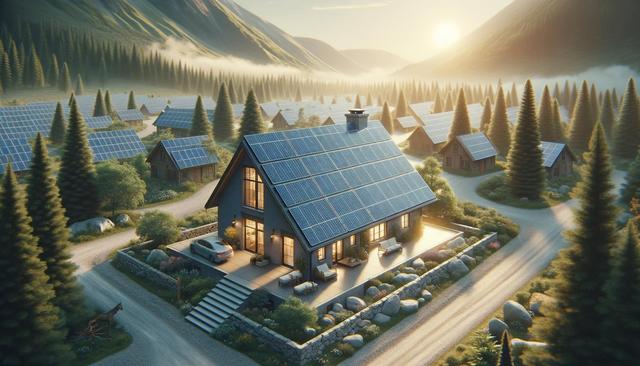What Is Solar Roofing?
Solar roofing refers to roofing systems that incorporate solar energy collection directly into the structure of the roof. Unlike traditional solar panels, which are mounted on top of existing roofs, solar roofing tiles or shingles are designed to blend in seamlessly with the roof’s architecture. These systems serve a dual function: they protect homes like conventional roofing materials while generating electricity from sunlight. This innovative approach to renewable energy has gained attention among homeowners looking to reduce utility bills and environmental impact.
There are two main types of solar roofing: building-integrated photovoltaics (BIPV) and solar shingles. BIPV systems are designed to complement or replace traditional building materials, whereas solar shingles are installed much like standard asphalt shingles. The integration of solar technology into roofing materials offers a sleek and less obtrusive alternative to conventional solar panels, making it an appealing option for those who value both aesthetics and functionality.
Benefits of Installing Solar Roofing
One of the primary benefits of solar roofing is its ability to generate renewable energy while maintaining the structural integrity and appearance of a home. By converting sunlight into electricity, solar roofs can significantly reduce reliance on fossil fuels and grid power. This not only helps in lowering electricity costs over time, but also contributes to a reduction in carbon emissions.
Additional advantages of solar roofing include:
- Enhanced property value due to energy-efficient upgrades
- Potential eligibility for government incentives or tax credits
- Long-term savings on energy bills
- Low maintenance requirements
Many solar roofing systems are also designed with durability in mind, offering resistance to harsh weather conditions such as hail, wind, and heavy rain. This makes them a practical solution for a wide range of climates and geographical areas.
Cost Considerations and Long-term Value
While the initial investment in solar roofing can be higher than traditional roofing materials, the long-term financial benefits often outweigh the upfront costs. Homeowners should consider the life expectancy of solar roofs, which typically ranges from 25 to 30 years, often with warranties that match or exceed those of traditional roofing systems. Over time, the energy savings and potential government incentives can help recover the initial investment.
Factors that influence the total cost include:
- Size and slope of the roof
- Type of solar roofing system installed
- Labor and installation costs
- Local utility rates and energy usage
It’s important for homeowners to obtain multiple quotes and conduct a thorough cost-benefit analysis before committing to a solar roofing project. Consulting with a reputable installer can help clarify the expected energy output and potential savings based on regional sunlight exposure.
Environmental Impact and Sustainability
Solar roofing contributes significantly to reducing a home’s carbon footprint. By utilizing solar energy, homeowners can decrease their dependence on energy derived from coal and natural gas, which are major contributors to greenhouse gas emissions. This shift is not only beneficial for individual households but also for the wider community by supporting cleaner air and a healthier environment.
In addition to reducing emissions, solar roofing materials are often recyclable and designed for minimal environmental impact during manufacturing. Many manufacturers are now focusing on improving the sustainability of their products by using eco-friendly materials and processes. This aligns with the broader movement toward green building practices and sustainable home design.
Key environmental advantages include:
- Reduced greenhouse gas emissions
- Lower water usage compared to fossil fuel-based power generation
- Decreased reliance on finite natural resources
For environmentally conscious homeowners, solar roofing represents a meaningful step toward sustainable living and energy independence.
Is Solar Roofing Right for Your Home?
Deciding whether solar roofing is a viable option depends on a variety of factors. The orientation and slope of your roof, local climate conditions, and regional solar incentives all play a role in determining feasibility. Homes with unshaded, south-facing roofs tend to get the most benefit from solar energy collection, but advances in technology have made solar roofing more adaptable to varied conditions.
Before making a decision, consider the following:
- Your long-term plans for the property
- Available sunlight and roof space
- Local building codes and zoning regulations
- Energy needs and usage patterns
Working with a qualified solar contractor can help evaluate these factors and determine if a solar roofing system aligns with your goals. In some cases, conventional solar panels may still be more cost-effective, but for those prioritizing design and integration, solar roofing offers a compelling alternative.
Conclusion: Investing in a Sustainable Future
Solar roofing offers a modern, efficient, and attractive solution for homeowners looking to reduce their environmental impact and energy expenses. By combining the functionality of roofing materials with clean energy generation, these systems present a forward-thinking approach to home improvement. Although the upfront costs may be higher, the long-term benefits in terms of savings, sustainability, and home value make solar roofing a worthy consideration for many. For those planning to stay in their homes for the long haul and seeking ways to contribute to a cleaner future, solar roofing is an option worth exploring.




Leave a Reply